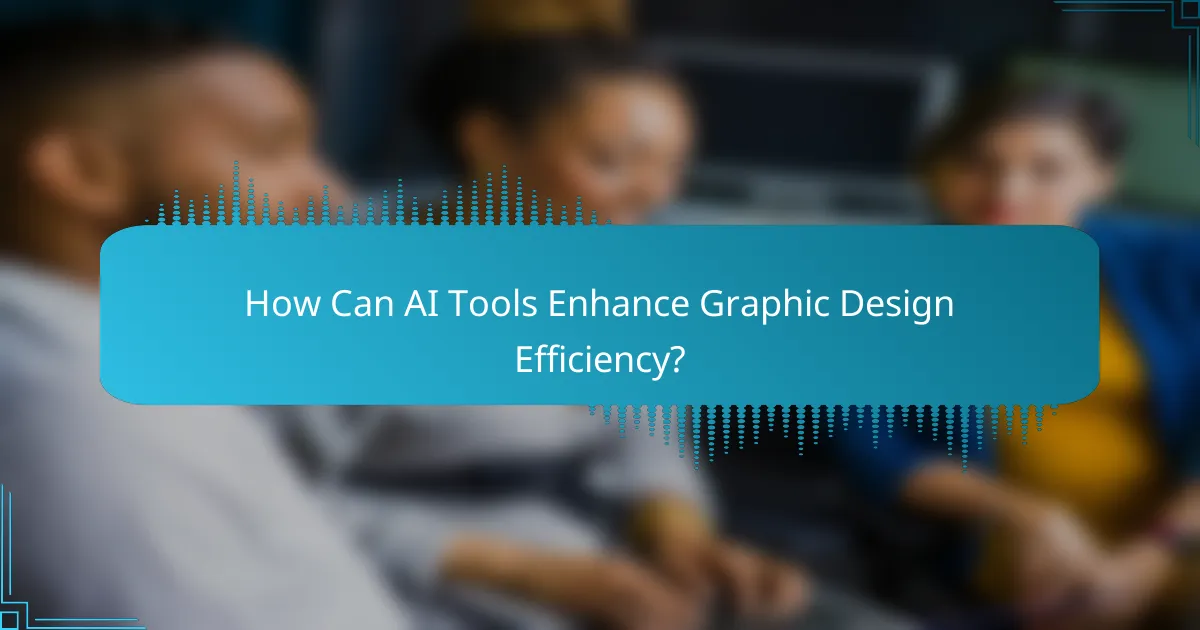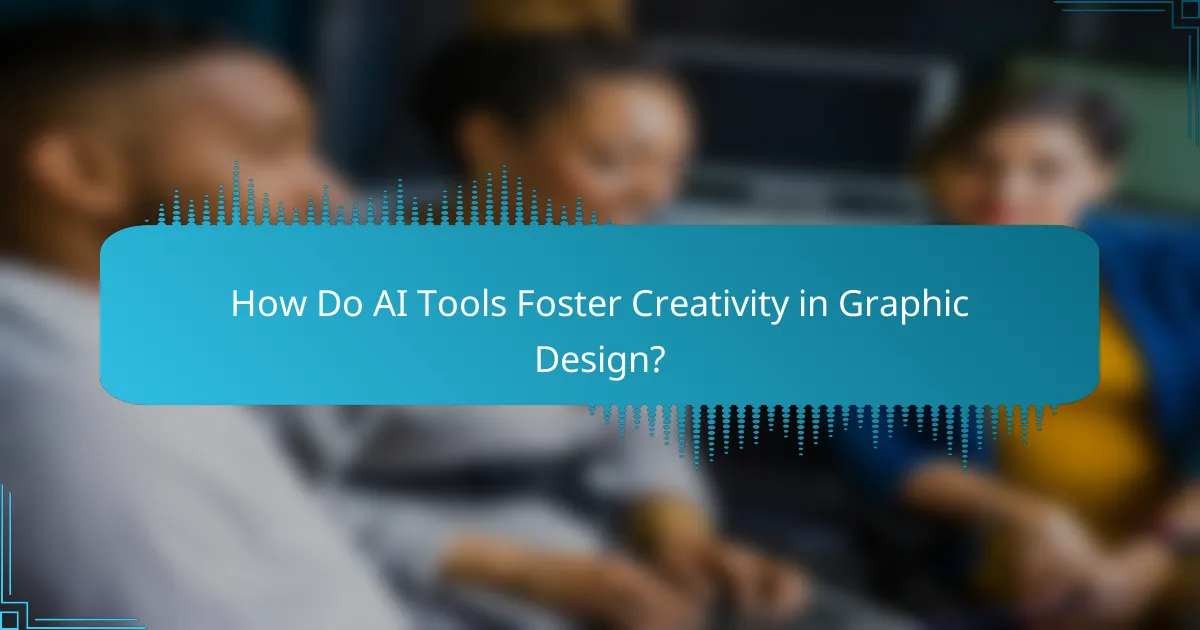AI-powered tools are revolutionizing graphic design by enhancing efficiency, fostering creativity, and improving collaboration among designers. By automating repetitive tasks and offering intelligent design suggestions, these tools enable designers to focus on their creative vision while streamlining workflows. Whether for professionals or amateurs, AI tools are becoming essential for producing unique and engaging designs.

How Can AI Tools Enhance Graphic Design Efficiency?
AI tools can significantly boost graphic design efficiency by automating repetitive tasks, providing intelligent design suggestions, and facilitating seamless collaboration. These enhancements allow designers to focus more on creativity while reducing time spent on mundane activities.
Automated Design Suggestions
AI-powered tools can analyze existing design elements and generate automated suggestions tailored to specific projects. These suggestions may include color palettes, typography choices, and layout options that align with current design trends.
For example, a tool might recommend a complementary color scheme based on the primary colors used in a project, helping designers make informed choices quickly.
Streamlined Workflow Integration
Integrating AI tools into existing design workflows can create a more cohesive and efficient process. Many AI design platforms offer plugins or APIs that connect with popular design software, allowing for a seamless transition between tasks.
Consider using tools that support integration with platforms like Adobe Creative Cloud or Figma, which can help maintain consistency and reduce the time spent switching between applications.
Time-Saving Templates
AI tools often come with a library of customizable templates that can save designers significant time. These templates are designed based on best practices and can be easily adapted to fit specific branding needs.
Utilizing templates can help speed up the design process, especially for common projects like social media graphics or marketing materials, allowing designers to focus on unique elements rather than starting from scratch.
Real-Time Collaboration Features
Many AI design tools offer real-time collaboration features that enable multiple team members to work on a project simultaneously. This functionality allows for instant feedback and adjustments, enhancing teamwork and reducing the back-and-forth typically associated with design revisions.
Tools like Canva or Figma allow users to comment directly on designs, making it easier to track changes and ensure everyone is on the same page during the design process.
Performance Analytics
AI tools can provide performance analytics that help designers understand how their work is received by audiences. By analyzing metrics such as engagement rates or user interactions, designers can make data-driven decisions to improve future projects.
For instance, a designer might use analytics to determine which design elements attract more clicks in a digital ad, allowing them to refine their approach for better results in subsequent campaigns.

What Are the Best AI-Powered Graphic Design Tools?
The best AI-powered graphic design tools enhance creativity and streamline workflows by automating repetitive tasks and providing intelligent suggestions. These tools cater to various design needs, from creating graphics to collaborating on projects, making them invaluable for both professionals and amateurs.
Adobe Sensei
Adobe Sensei integrates AI and machine learning into Adobe’s suite of design applications, enhancing user experience by automating mundane tasks. It analyzes user behavior and design patterns to offer personalized recommendations, making design processes faster and more efficient.
For instance, Sensei can automatically tag images, suggest layouts, and even create variations of designs based on user input. This tool is particularly beneficial for teams looking to maintain brand consistency while saving time on repetitive tasks.
Canva Magic Write
Canva Magic Write is an AI-driven feature that assists users in generating text content for their designs. It helps create catchy headlines, engaging descriptions, and even social media posts, allowing designers to focus more on visuals while ensuring their messaging is compelling.
This tool is ideal for marketers and content creators who need to produce a large volume of graphics quickly. By leveraging Magic Write, users can save significant time and enhance their creative output without sacrificing quality.
Figma with AI Plugins
Figma, a popular collaborative design tool, supports various AI plugins that enhance its functionality. These plugins can automate tasks such as generating design assets, optimizing layouts, and even providing design critiques based on best practices.
Using AI plugins in Figma can significantly reduce the time spent on design iterations. For example, plugins like “Design System Organizer” help maintain consistency across projects, while “Content Reel” provides quick access to reusable assets, streamlining the design workflow.
Designify
Designify is an AI tool that simplifies the design process by automatically enhancing images and creating professional-quality graphics. Users can upload their images, and Designify will apply various enhancements, such as background removal and style adjustments, in just a few clicks.
This tool is particularly useful for e-commerce businesses looking to improve product images quickly. By providing high-quality visuals without the need for extensive design skills, Designify empowers users to create appealing graphics effortlessly.
Looka
Looka is an AI-powered logo maker that helps users design unique logos based on their preferences and industry. By inputting specific details like business name, colors, and styles, Looka generates a variety of logo options that users can customize further.
This tool is perfect for startups and small businesses that need a professional logo without the cost of hiring a designer. Looka’s intuitive interface allows users to create a logo in minutes, making it a practical choice for those on a budget.

How Do AI Tools Foster Creativity in Graphic Design?
AI tools enhance creativity in graphic design by automating repetitive tasks, providing inspiration, and enabling designers to explore new styles. These technologies allow for innovative approaches while maintaining efficiency, ultimately leading to more unique and engaging designs.
Inspiration Generation
AI-powered tools can generate a wide array of design ideas based on user inputs or existing works. By analyzing trends and styles, these tools suggest color palettes, layouts, and themes that align with current market preferences. This capability helps designers overcome creative blocks and discover fresh concepts quickly.
For instance, platforms like Canva and Adobe Spark utilize AI to recommend design elements tailored to specific projects, making it easier for designers to kickstart their creative process.
Customizable Design Elements
AI tools allow designers to create customizable design elements that can be easily modified to suit various projects. Users can adjust colors, shapes, and sizes with just a few clicks, streamlining the design process. This flexibility enables designers to maintain a consistent brand identity while experimenting with different aesthetics.
Tools like Figma and Sketch offer features that let users manipulate components dynamically, ensuring that designs can evolve without starting from scratch. This adaptability is crucial for meeting diverse client needs efficiently.
Style Transfer Capabilities
Style transfer technology enables designers to apply the visual characteristics of one image to another, creating unique blends of styles. This technique can transform a simple graphic into a work of art by mimicking the styles of famous artists or specific design trends. It opens up new avenues for creativity by allowing designers to experiment with various artistic influences.
For example, tools like DeepArt and Runway ML allow users to upload images and apply different artistic styles, resulting in visually striking designs that stand out. However, designers should be mindful of copyright issues when using styles derived from existing artworks.

What Collaboration Features Do AI Tools Offer?
AI-powered graphic design tools enhance collaboration by providing features that streamline communication and project management among team members. These tools facilitate real-time sharing, version tracking, and feedback mechanisms, making it easier for designers and clients to work together effectively.
Cloud-Based Sharing
Cloud-based sharing allows team members to access design files from anywhere, promoting flexibility and remote collaboration. Tools like Adobe Creative Cloud or Canva enable users to upload and share their work instantly, ensuring everyone has the latest version without the hassle of email attachments.
When using cloud-based sharing, consider the security of your files. Opt for platforms that offer encryption and secure access controls to protect sensitive designs. Additionally, ensure that all team members are familiar with the sharing process to avoid confusion.
Version Control Systems
Version control systems track changes made to design files, allowing teams to revert to previous iterations if needed. This feature is crucial for maintaining the integrity of a project, especially when multiple designers contribute to the same file.
Popular tools like Figma and GitHub for design files provide robust version control options. It’s advisable to establish a naming convention for versions and regularly document changes to facilitate easy navigation through the design history.
Feedback and Commenting Tools
Feedback and commenting tools enable team members and clients to leave notes directly on design files, streamlining the review process. This feature helps clarify suggestions and reduces the back-and-forth communication typically associated with feedback.
When utilizing feedback tools, encourage clear and constructive comments to enhance collaboration. Set deadlines for feedback to keep projects on track, and consider using color-coded comments to categorize suggestions by priority or type.

What Criteria Should You Consider When Choosing an AI Graphic Design Tool?
When selecting an AI graphic design tool, prioritize features that enhance efficiency, creativity, and collaboration. Consider factors such as ease of use, integration capabilities, and the specific design tasks you need to accomplish.
Ease of Use
Ease of use is crucial when choosing an AI graphic design tool. Look for intuitive interfaces that allow both beginners and experienced designers to navigate the software without extensive training. Tools that offer drag-and-drop functionality or pre-designed templates can significantly speed up the design process.
Additionally, consider the availability of tutorials and customer support. A tool with comprehensive resources can help users quickly overcome challenges and maximize their creative potential.
Integration Capabilities
Integration capabilities are essential for seamless workflow. Ensure the AI graphic design tool can connect with other software you use, such as project management tools, cloud storage, or social media platforms. This connectivity allows for smoother collaboration and sharing of designs.
Check if the tool supports popular file formats and can export designs directly to your preferred platforms. This feature can save time and reduce the hassle of manual uploads.
Specific Design Tasks
Identify the specific design tasks you need the AI tool to perform. Some tools excel in creating social media graphics, while others may be better suited for print materials or branding projects. Make a list of your primary design needs and compare how different tools address them.
For instance, if you require logo design, look for tools that offer logo generation features or customizable templates. If you focus on marketing materials, prioritize tools that provide a variety of layout options and design elements.


